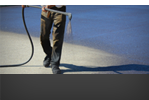Put Your Pavement to the Test
What you don’t know about your pavement may be costing you money. Preventative maintenance is the key to making your pavement investment last, so Put Your Pavement to the Test. Below is a point guide system to help you evaluate the condition of your pavement and increase its value.
Directions: Rate the condition of your pavement from 1 to 5, with 5 being the worst. Click the check box next to the appropriate rating. Click “submit” when you have rated each category to calculate your total and be directed to our results and recommendation page.







